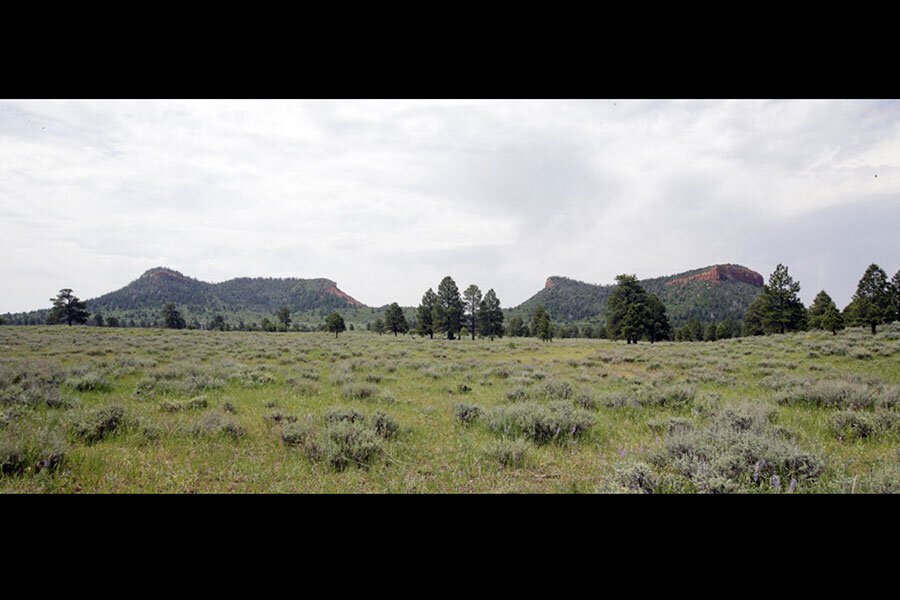Bears Ears: Why another proposed monument is dividing Utahns
Loading...
Efforts to designate over nearly two million acres of land in what is often known as the Bears Ears region as a national monument is inciting controversy among many in southeastern Utah.
For a coalition of native American tribes and environmentalists, designating the Bears Ears land as a monument will help protect an area long considered sacred, as it is home to 100,000 archaeological sites. But for Utah lawmakers, rural residents, and other native Americans, the proposal amounts to a federal overreach that could threaten local development.
Interior Secretary Sally Jewell plans to visit the region this summer, a move that could possibly proceed President Obama officially designating the area as a national monument. Some lawmakers warn more federal intervention could cause the conflict to boil over into conflict reminiscent of the armed standoff at a wildlife refuge in Malheur, Ore. last fall.
“There is a lot of conflict that has escalated into being on the precipice of violence that is unnecessary and unwarranted,” warned Rep. Jason Chaffetz (R) of Utah, who opposes the designation of the area as a monument, according to the Washington Post.
For many native American tribes, however, the area represents a sacred link to their past.
“We don't want to forget about our ancestors,” Malcolm Lehi, a Ute Mountain Tribal Commissioner, told the Associated Press. “Through them we speak. That's the whole concept of protecting and healing this land. They are still here among us as the wind blows.”
But opponents say that while the area’s stunning vistas are a natural treasure that should be preserved, they worry that a federal designation could impede both oil and gas development and residents’ ability to camp, hike, and bike on the land.
"These areas are sacred to me because I've grown up here," rancher Kenny Black, a descendant of Mormon pioneers in the region, told the AP. "They're part of my history and my culture as well."
Mr. Black, who has cattle grazing permits in area covered by the monument proposal, argued that the current combination of state and federal land management is working.
Members of Utah's all-Republican congressional delegation are championing an alternative plan that has undergone what its sponsors say is extensive revision after criticism of a draft from environmental groups in January.
The bill, sponsored by Rep. Chaffetz and Rep. Rob Bishop, now calls for 1.4 million acres of the Bears Ears region to be split in two, with the southern portion set aside for traditional Native American uses, according to the Desert News.
The northern half of the area would continue to allow existing outdoor recreation uses and grazing. Local tribes will also have a co-management position in how the land is used, Fred Ferguson, Chaffetz’s chief of staff, told the Deseret News.
Some tribes and environmental groups raised concerns that without federal protection, looting of objects from the region – there have been at six confirmed incidents in the past six months, the Post reports – could continue unabated.
Opponents of the federal monument proposal argue the looting reports are exaggerated. They allege that the monument proposal represents an effort by environmental groups to seize more control over the land.
Land-use issues have "become a political rallying cry for Republicans, many who want to see federally managed lands in the West ceded to state control." GOP politicians have criticized the president's use of the antiquities act, as The Christian Science Monitor's Patrik Jonsson wrote in February:
Despite being sold in 1906 as a way for a president to protect small parcels for scientific reasons, [the act] has morphed into method for preserving vast tracts without Congressional approval. The Act has withstood myriad legal and legislative challenges. “[T]he outer bounds of its powers remain unknown,” Brent Hartman writes in Public Land and Resources Law Review.
“The intent of the Antiquities Act is not to act as the President’s magic wand to commandeer land,” Representative Bishop said. “… It’s an authoritarian act that ignores people under the guise of preservation.”
In 2015, Western state legislatures introduced 37 bills in favor of local land seizure, the Monitor reported.
A spokeswoman for Ms. Jewell, who is embarking on a listening tour across the state, noted that the secretary’s visit doesn’t necessarily mean that Mr. Obama will designate the area as a national monument. Presidents frequently name monuments in their final years of office, the AP reports.
But for some regular visitors, a monument is a needed step to keep a valuable link to the area’s history.
“Every monument has its purpose. This one has medicines here. This one has prayers, offerings, something that is very spiritual to us,” Jonah Yellowman, a Navajo spiritual adviser who travels up to the area to gather wood for his home and for rituals, told the AP. “We'd like to keep it that way.”
This report includes material from the Associated Press.





